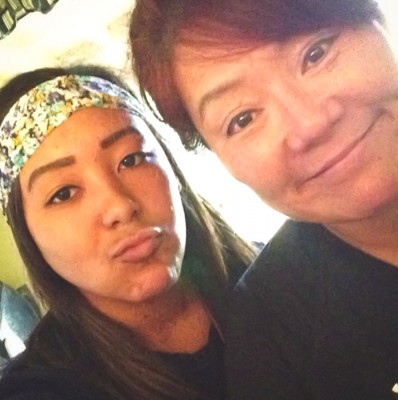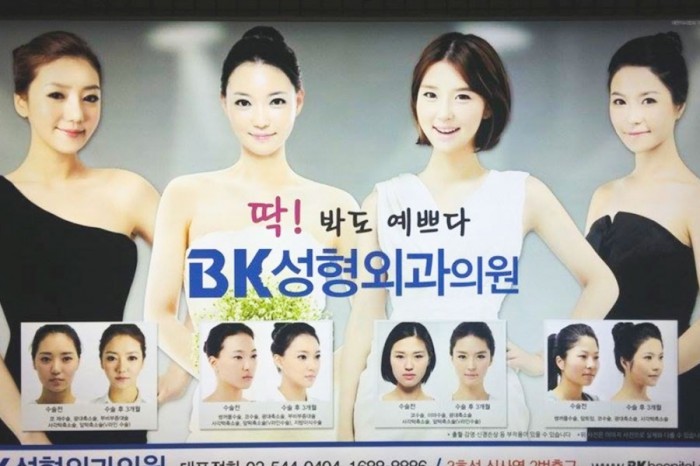South Korea is the plastic surgery capital of the world. One in five Korean women have had some kind of cosmetic surgery, and certain Seoul neighborhoods are lined with clinics, advertisements and billboards showing before and after photos.
Eyelid surgery, also known as blepharoplasty, is one of the most common procedures. Koreans are often born without a crease in their eyelid; The surgery aims to “correct” that by making an incision above the eye to produce double eyelids and a permanent crease.
Korean Americans have begun to adopt the trend as well. According to The American Academy of Facial Plastic and Reconstructive Surgery, plastic surgery is on the rise amongst Asian Americans overall, and 44% of those getting surgeries have a blepharoplasty.
But what is shared openly — and even celebrated in Korea as self-improvement is a huge taboo in the U.S.
I have heard Korean American friends blatantly deny having the surgery, even going so far as to delete old pictures from their social media accounts to hide their pre-surgery selves.
So why the shame? I decided to ask some of my Korean American friends and family to find out.
I knew interviewing Korean Americans about the double eyelid surgery would be difficult. To even ask them felt like a violation, and almost no one was willing to talk about it.
Sharon Lee, who was born with double eyelids, was willing to talk though. She says that she’s often been praised for the appearance of her eyes and eyelids throughout her life.
“I definitely feel privileged to have double eyelids, of course, because some Koreans dream of having double eyelids,” Lee said. “People born in Korea use the surgery as a bragging right because it is a sign of wealth, and status is important.”

Lee had some interesting ideas about why it might be such a taboo to admit having had the surgery here.
“The surgery among Korean-Americans is frowned upon because we grew up in American culture to gain status by integrity and hard work,” she said. “If you think about it, most people in America that get procedures done wouldn’t want someone to come up to them and point out their surgery when it is their privacy.”
Jason Park, who is from Washington but now lives in South Korea, was surprised to discover how popular and public the surgery is there.
“I live in Apgujeong [a neighborhood in Seoul] now, which is commonly known here as the plastic surgery capital,” Park said. “It is so cheap, so easy and routine here to get cosmetic surgery, it’s not uncommon to see people with bandages all over their face as they walk around. It is a normal thing to see.”
Plastic surgery can be a sign of wealth in South Korea. But the knife cuts both ways. Using plastic surgery to gain and idealized appearance is also perceived as a stepping stone to wealth and success, especially for women.
“We live in a society where someone’s image and age matter for women, whether it is getting a good job or finding a good husband,” Park said. “In America, it’s illegal to discriminate on race and looks and every little thing, yet Korea is still decades behind such moral ethics. Even applying for an English teaching job, or any job here, a picture is required and people are hired because of their looks.”
For both Koreans and Korean Americans I’ve talked to, it’s a foregone conclusion that the larger eyes resulting from the surgery are more beautiful and improve one’s appearance.
“A lot of people want the surgery done because bigger eyes are more beautiful. Western ideals have a big influence on people so that is probably where that idea comes from,” Lee said. “But some are old fashion and may say that having the eyelid surgery can almost take the natural Korean look out of you.”
Clark Sorenson is a professor at the Jackson School of International Studies at the University of Washington who teaches many different courses about Korea and Korean culture. In his perspective, the eyelid surgery is a deviation from Korean tradition.
“Old fashioned Koreans would say that your body was given to you by your parents, and it would be disrespectful for them to try to change it. Nowadays in Korea, it isn’t so old fashioned anymore,” Sorenson said.
Sorenson figures that the difference perceptions of shame around the surgery are based on the different experiences of Koreans and Korean Americans.
“I think it is different in being Korean American versus being Korean-Korean,” Sorenson said. “Everyone in a racial minority gets some kind of discrimination or insensitive comments like the slant eyes gesture. I can see why they are sensitive, while in Korea, the citizens are exposed to just Korean people.”
Based on my own experience, he might be right.
I’m half Korean, but I was born with double eyelids. Even still, when I was growing up, kids would jokingly pull their eyes outward at me or squint at me to imitate my eyes.
Many Korean Americans told me I had beautiful eyes. I did not understand the fuss about it because I assumed my eyes came from my mother, Seong Hye Graham.

But when I brought the topic up with her recently, I was shocked to learn that she had eyelid surgery too.
Initially I felt uneasy to ask her about it, because of all the shame I’d heard from other people. To my surprise she spoke candidly about a part of her past I’d never known about.
“I got the surgery done around 30 years ago in Korea,” she said. “I just wanted bigger eyes because it is more beautiful and why not have the surgery?”
She says that when she moved to the United States soon after she noticed that the Korean-Americans here are very quiet about the surgery.
“Many Asian-Americans may be hush-hush about it because people always assume the procedure is done because we want to look more white,” she said. “We just want bigger eyes. It is generally known that bigger eyes are more attractive.”



I think Koreans have natural beauty: dark thick straight hair that can grow very long, small bodies, sometimes full, plump lips and unique (Asian) eyes shapes. Sleepy eyes are sexy to me. Slanted eyes (up and out) look cunning and seductive. Small noses fit the natural Asian profile, but I admit that the men look more masculine with a more prominent bridge. Surgeons often use overly angular bridges on the women and it looks like a toothpick shoved up the nose. The newer turned up is less aggressive against the natural features, softer and easier on the eyes. Anyway, Asian beauty stands on its own as do all other national groups, but I’m biased to full, plump lips.
Thanks for your article and the differing opinions of Korean nationals and those in the Diaspora. You say that South Korea is the plastic surgery capital of the world. What do you mean by that? I would be interested in getting your references! According to statistics on The International Society of Aesthetic Plastic Surgery, the US, Brazil and Japan lead with South Korea in 4th place for most cosmetic procedures in 2014. However, this includes surgical and nonsurgical. Could you share your data collection? I’m very curious and would be very grateful as it’s for my research. Thank you.
Thank you for sharing this post. Actually, Iran is the capital of plastic surgery, although that Singapore and Korea are right next to it. I had a double eyelid surgery in Singapore – the surgeon was highly experienced and the cost was lower that the cost of blepharoplasty in Korea.